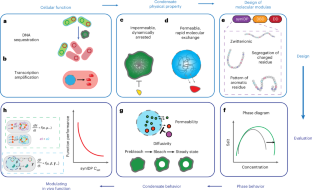細胞プロセスを制御するために生体分子を分離・捕捉する合成凝縮の新分野を開拓。 Emerging field of synthetic condensates isolates or traps together biomolecules to control cellular processes
2023-02-06 デューク大学(Duke)
◆研究者らは、この手法が、細菌間で遺伝子の指示を広めるプロセスと、哺乳類細胞のタンパク質回路を調節するプロセスの2つの細胞プロセスに影響を与えることを実証した。この成果は、病気の理解と治療に役立つ新しい戦略の開発や、抗生物質耐性の病原菌の蔓延を食い止めるために非常に有益であると考えられます。
◆この成果は、2月6日発行の科学雑誌『Nature Chemical Biology』オンライン版に掲載されます。
◆この論文の中で、Dai、Chilkoti、Youと、ワシントン大学セントルイス校のGene K. Beare特別教授で生体分子凝縮センター所長のRohit V. Pappuの研究室の同僚たちは、様々な生体分子プロセスを閉じ込める様々な種類の凝縮を細胞に作らせる合成遺伝的命令の作成を実証している。その一例として、彼らはプラスミドと呼ばれる小さなDNAの束が、遺伝子の水平伝播と呼ばれるプロセスでバクテリア間を移動するのを阻止する凝縮体を構築した。このプロセスは、病原菌が抗生物質に対する耐性を獲得するために用いる主要な方法の1つであり、これを阻止することは、「スーパーバグ」の発生と増殖に対抗するための重要な一歩になると考えられる。
◆研究チームはまた、この方法を用いて、大腸菌のDNAからRNAへの転写を制御し、異なる因子をまとめて特定の遺伝子の発現を効果的に増幅できることも示している。さらに、この方法を用いて、哺乳類細胞のタンパク質回路を調節することも実証している。特定の遺伝子の活性やタンパク質の活性を調節することは、さまざまな病気、特に遺伝病と闘うための有用な方法となる可能性があります。
<関連情報>
- https://pratt.duke.edu/about/news/synthetic-compartments
- https://www.nature.com/articles/s41589-022-01252-8
細胞制御のためのプログラマブル合成生体分子凝縮体 Programmable synthetic biomolecular condensates for cellular control
Yifan Dai,Mina Farag,Dongheon Lee,Xiangze Zeng,Kyeri Kim,Hye-in Son,Xiao Guo,Jonathan Su,Nikhil Peterson,Javid Mohammed,Max Ney,Daniel Mark Shapiro,Rohit V. Pappu,Ashutosh Chilkoti & Lingchong You
Nature Chemical Biology Published:06 February 2023
DOI:https://doi.org/10.1038/s41589-022-01252-8

Abstract
The formation of biomolecular condensates mediated by a coupling of associative and segregative phase transitions plays a critical role in controlling diverse cellular functions in nature. This has inspired the use of phase transitions to design synthetic systems. While design rules of phase transitions have been established for many synthetic intrinsically disordered proteins, most efforts have focused on investigating their phase behaviors in a test tube. Here, we present a rational engineering approach to program the formation and physical properties of synthetic condensates to achieve intended cellular functions. We demonstrate this approach through targeted plasmid sequestration and transcription regulation in bacteria and modulation of a protein circuit in mammalian cells. Our approach lays the foundation for engineering designer condensates for synthetic biology applications.


